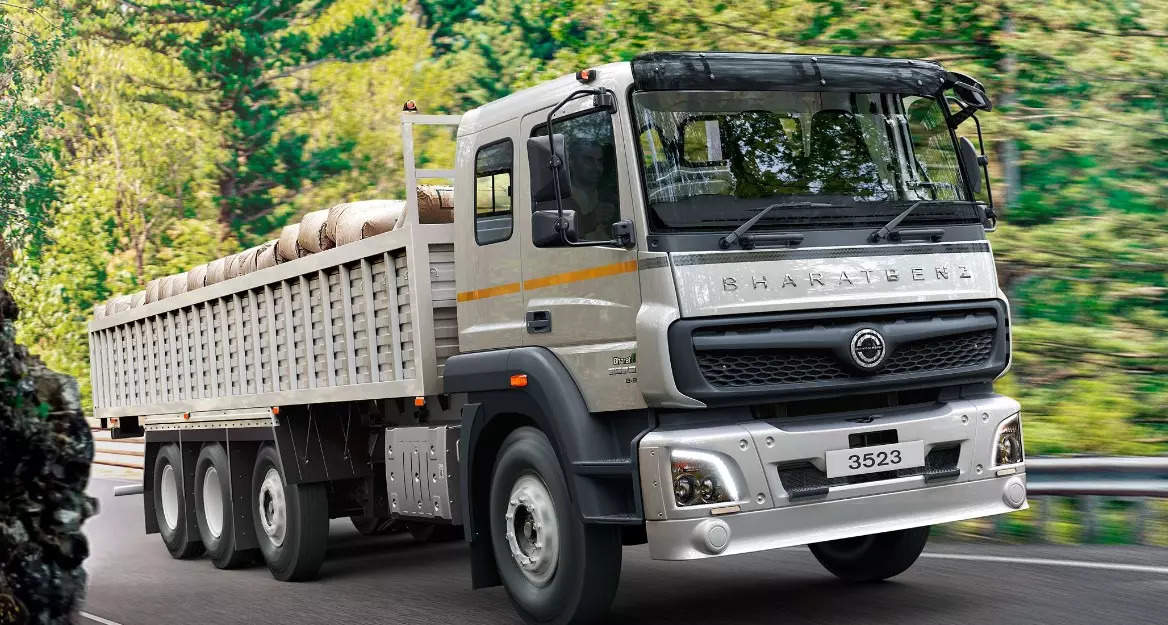
New Delhi: From Satyakam Arya’s point of view, Daimler India Commercial Vehicles (DICV) is well and truly poised on the fast track of growth.
“I meet customers on a regular basis and they say our products are way superior to anything they have seen in terms of turnaround time, fuel efficiency and maintenance costs. The uptime they get with our trucks along with their reliability levels are phenomenal,” the Managing Director and CEO of DICV told ETAuto.
The company, whose products sport the BharatBenz brand, has been around for nearly 12 years and reported its best-ever performance in calendar 2023. Its bread-and-butter business of medium and heavy commercial vehicles outperformed the market as also its buses.
A deeper analysis shows that the market saw good growth of tractor trailers as well as the construction/mining truck segment while the long haul multi axle category shrunk. DICV grew well in both these high performance categories which “reflect our strengths” in fuel efficiency and lower maintenance costs.
What gives Arya immense satisfaction is that the “one million km club of customers” has now grown to 2000 plus. These people have used the same powertrain to reach the one million km mark without a fuss. Nothing could be more important to fleet operators in a competitive B2B arena.
Repeat buying
“We are 11 years in the market and still young but customers understand what we are and trust our brand,” continued Arya. A study carried out by the company showed that the first time buyers buy two BharatBenz trucks on an average, going up to eight the second time and 22 the third time. This “speaks volumes about their faith” in the brand especially when it has helped their business to grow.
According to him, DICV is also ahead of the curve when it comes to safety. Even when it entered the market, it steered clear of cowls (these do not have a fully-built cabin around the chassis) despite the fact that they accounted for a lion’s share of the market at over 80 per cent. The reasoning was simple — “we were opposed to cowls.”
Today, the cowl penetration is down to 35% which vindicates the company’s stand and has, in fact, proved that “we are shaping the market and telling customers that a fully-built steel cabin is so much better”. DICV also upgraded its heavy duty cabins last year to conform to European crash safety norms which implies that “we are two steps ahead”.
As Arya put it, there was no compelling reason for the company to do this from the viewpoint of any legislation but the overarching goal was to have safer cabins in place. “Our customers value this and our products/services are acknowledged as being superior,” he added.
The DICV mantra is to stay ahead and shape the market with appropriate products. Arya said the country’s focus on infrastructure creation meant that the future looked bright. This sentiment has been echoed by the parent company, Daimler Truck, which is bullish on the truck growth story in India for the remainder of this decade.
Hub and spoke model
The next logical step in India would be to have a robust hub and spoke model that will complement the efforts in building roads, highways and bridges. “We are seeing strong commitment to the logistics policy,” Arya said. With more roads, customers will shift to higher horsepower trucks and from a multi axle rigid to a tractor trailer. Simply put, this means that the tractor keeps on moving with a new trailer after the previous one is parked for unloading.
When logistics parks are in place, this will increase the momentum and goods will be offloaded by long haul tractor trailers outside big cities. Medium and heavy trucks will then transport the goods to warehouses with smaller commercial vehicles taking over for last mile deliveries.
When this model becomes a reality across the Indian landscape, Arya said logistics costs, which are now 13% of GDP, would come down to single digits. From the technology end, connected vehicles will also help bring down logistics costs because thanks to data on fuel efficiency, location of the trucks, driving behaviour etc. “In the next 5-7 years, there will be different levels of logistics costs if things go according to plan,” he said.
DICV also has a robust export business which has managed to cope with the Red Sea crisis. Arya reiterated that it “hasn’t been too much of an issue” even while there has been an increase in transit time and costs. This is because ships have to now take on longer, albeit safer, routes to steer clear of potential strikes.
Geopolitical uncertainty
“We have to create a higher inventory of critical parts keeping the higher transit time in mind. Geopolitical uncertainty is a reality to reckon with and there are two active wars happening which need to be factored in for business planning,” he added.
Beyond this, 2024 will see half the world population voting for new governments. Elections “create softness in the markets” and Arya said export volumes were likely to remain flat. Back home in India, the election fever has already reached a crescendo and sales of medium and heavy trucks are already down by over 10% in the January-March period.
Arya said he expected Q2 to be flat too for industry while a rebound of sorts could happen in the third and fourth quarters. The annual tally of medium and heavy trucks will then remain flat at 3.5 lakh units in 2024 and it will be a good six years longer before the magical mark of half a million units becomes a reality. Should the scrappage policy come into effect soon, this number may be achieved earlier but that remains a million dollar question.
As for clean fuels, the DICV chief said the company would remain focused on electric and hydrogen. “We have done different studies on fuels and gas is not a sustainable solution,” he added. While it helps reduce emissions, it also impacts power which then affects turnaround time and freight efficiency.
“Gas is a good but not great solution. For zero emissions, BEVs and hydrogen work for intracity and long hauls. These are also sustainable options and we will invest in them,” Arya said. If the market, however, looks at gas as a transit option, “we will look at this play” but this will be only an interim solution.
AI disruption
There has also been a lot of talk on artificial intelligence and its propensity to cause disruptions across sectors. From his viewpoint, AI would also add value while “changing the way we work” and increase efficiencies. Besides this, it can help in customer interface and planning.
DICV is piloting use of AI for forecasting use of different parts (given the myriad emission standards across the world where it supplies spares) and Arya was confident that “there are areas where it can add value”. He said there would be a “major shift of skills” on the lines of what occurred with new technology in the past.
“Some mundane jobs will disappear and new ones will come in. How we manage the transition is the challenge and upskilling people will be the top priority for any CEO. I believe a shift of skills will happen and we need to be ready for it,” Arya said.

















